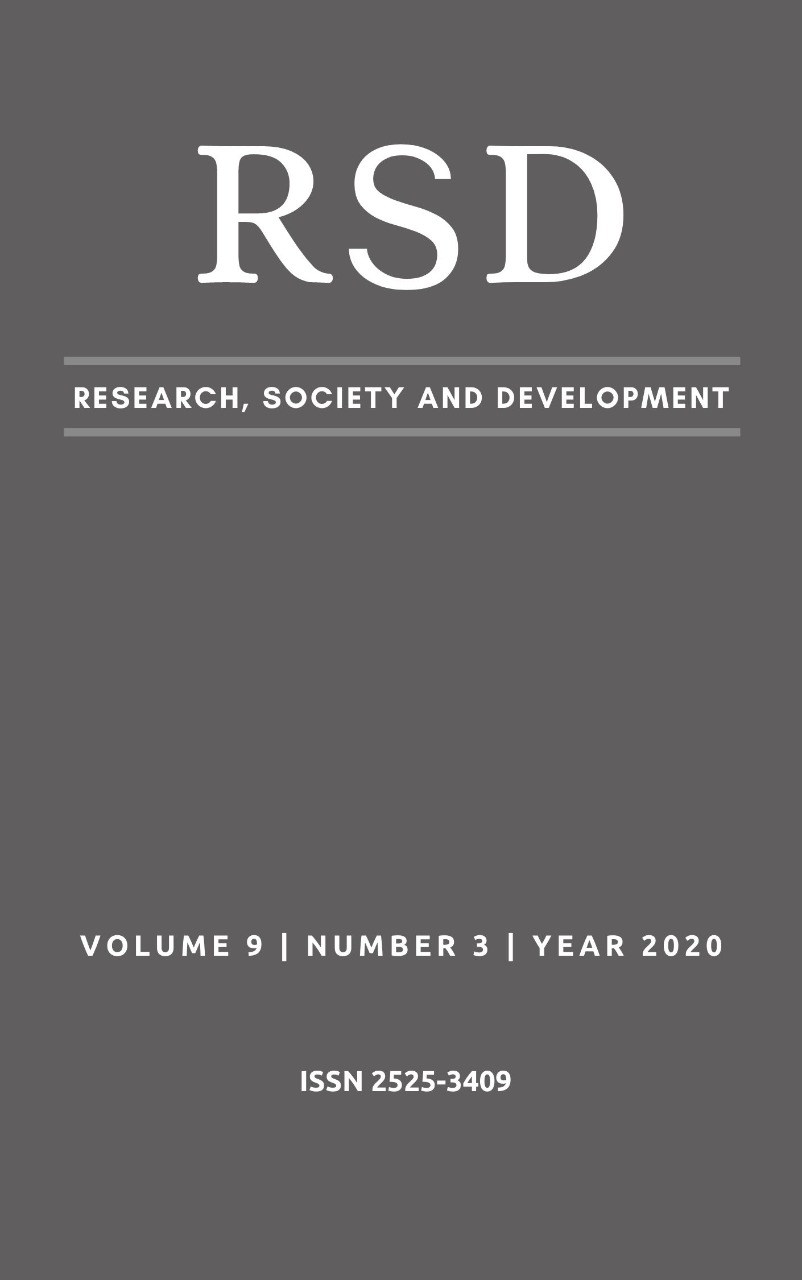Caracterização de sintomas e crescimento em Abobrinha Italiana (Cucurbita pepo L.) sob carencia de micronutrientes
DOI:
https://doi.org/10.33448/rsd-v9i3.2359Palavras-chave:
Cucurbitáceas, Nutrição mineral de micronutrientes, Sintomas.Resumo
Os vegetais precisam de nutrientes para manutenção da sua vida, devido às funções que esses elementos desempenham. Este trabalho teve como objetivo avaliar os sintomas típicos de carência nutricional em Abobrinha Italiana referente aos micronutrientes, através do diagnóstico visual e o crescimento. O delineamento estatístico utilizado foi o DIC com três repetições, contendo 6 tratamentos, em solução nutritiva. Os tratamentos foram: solução nutritiva completa (controle), soluções nutritivas com omissões individuais de B, Cu, Fe, Mn e Zn. Após a germinação, as mudas foram transferidas para a solução nutritiva completa, com 10% da sua força iônica (período de adaptação), as quais permaneceram sob aeração constante e após foram transplantadas para vasos de plástico (8L) com solução nutritiva. Os sintomas observados, foram fotografados e descritos. Após a manifestação dos sintomas visuais de deficiência, os tratamentos foram colhidos. Com quinze dias, as plantas sob omissão de boro começaram a apresentar redução no crescimento. Através dos parâmetros de crescimento e produção de matéria seca avaliados, observou-se que as omissões proporcionaram diferenças significativas nas plantas de Abobrinha Italiana. Sob omissão severa, as folhas lançadas foram mal formadas, menores e mais grossas, e ainda morte dos pontos de crescimento. A omissão dos nutrientes B e Fe em solução nutritiva podem ser traduzidas em sintomas característicos de deficiência de cada nutriente. A omissão de micronutrientes afeta o de Abobrinha Italiana. A omissão de micronutrientes que mais limita as diferentes partes a plantas são Fe e B.
Referências
Brasil. Ministério da Agricultura. (1992). Normais climatológicas: 1961-1990. Brasília: EMBRAPA/DNMET. pp. 84.
Basso, S. M. S. (1999). Caracterização morfológica e fixação biológica de nitrogênio de espécies de Adesmia DC e Lótus L. pp. 268. Tese (Doutorado em Zootecnia) – UFRGS, Porto Alegre-RS.
Epstein, E., & Bloom, A. (2004). Mineral nutrition of plants. Sunderland: Sinauear Associates, 403 p
Fernandes, C. N. V., Azevedo, B. M., Camargo, D. C., Dias, C. N., Rebouças Neto, M. O., & Costa, F. R. B. (2016). Potassium fertilizer applied by different methods in the zucchini crop. Revista Brasileira de Engenharia Agrícola e Ambiental. 20(7), 643-648. https://dx.doi.org/10.1590/1807-1929/agriambi.v20n7p643-648
Fernandes, L. A., Alves, D. S., Ramos, S. J., Oliveira, F. A., Costa, C. A., & Martins, E. R. (2005). Nutrição mineral de plantas de maxixe-do-reino. Pesquisa Agropecuária Brasileira. 40, 719-722. http://dx.doi.org/10.1590/S0100-204X2005000700014
Ferreira, D. F. (2010). SISVAR software: versão 5.6. Lavras: DEX/UFLA. Software
Frazão, J. E. M. (2008). Diagnose da deficiência nutricional e crescimento do Bastão-do-Imperador Etlingera elatior (Jack) R. M. Smith com o uso da técnica do elemento faltante em solução nutritiva. 67p. Tese (Doutorado em solos e Nutrição de Plantas) – Universidade Federal de Lavras, Lavras-MG. http://www.sidalc.net/cgi-bin/wxis.exe/?IsisScript=AGB. xis&method=post&formato=2&cantidad=1&expresion=mfn=248746
Hoagland, D. R., & Arnon, D. L. (1950). The water culture methods for growing plants whitout soil. Berkeley. California Agriculture Experiment Station. pp. 32. (Bulletin, 347).
Lange, A.; Martines, A. M.; Silva, M. A. C.; Sorreano, M. C. M.; Cabral, C. P., & Malavolta, E. (2005). Efeito de deficiência de micronutrientes no estado nutricional da mamoneira cultivar Iris. Pesquisa Agropecuária Brasileira. 40(1), 61-67. Brasília. Jan. http://dx.doi.org/10.1590/S0100-204X2005000100009.
Malavolta, E. (2006). Manual de nutrição mineral de plantas. São Paulo: Editora Agronômica Ceres. pp. 638.
Malavolta, E., Vitti, G. C., & Oliveira, S. A. (1997). Avaliação do estado nutricional das plantas: princípios e aplicações. 2ª ed. Piracicaba: POTAFOS. pp. 319.
Mascarenhas, H. A. A., Esteves, J. A. Fátima., Wutke, E. B., Reco, P. C., Leão, P. C. L. (2013). Deficiência e toxicidade visuais de nutrientes em soja. Nucleus, 10(2), 281-306. http://dx.doi.org/10.3738/1982.2278.974
Pinho, P. J. (2007). Deficiências nutricionais em bananeira ornamental (Musa velutina h. wendl. & drude): Alterações químicas e morfológicas e caracterização de sintomas visuais. pp. 147. Tese (Doutorado em solos e Nutrição de Plantas) – Universidade Federal de Lavras, Lavras-MG. https://dx.doi.org/ 10.14295/rbho.v18i1.694.
Ramoni, E.O., Balbi, M.E., Faria, F.D., Lutz, B.Z., & De Morais, G.C.N. (2014). Determinação química e nutricional de sementes de abóbora (Cucurbita spp, Cucurbitaceae ) comercializadas salgadas na cidade de Curitiba PR, Brasil. Visão Acadêmica, Curitiba. 15(2), 17-27. http://dx.doi.org/10.5380/acd.v15i2.38322.
Rozane, D. E., Brunetto, G., & Natale, W. (2017). Manejo da fertilidade do solo em pomares de frutíferas. Informações agronômicas. 160, 16-29. http://www.ipni.net/publication/ia-brasil.nsf/0/11422D5849073C7983258210003DA5A8/$FILE/Page16-29-160.pdf
Souza, F. B. M., Pio, R.;, Coelho, V. A. T., Rodas, C. L., & Silva, I. P. (2015). Sintomas visuais de deficiência de macronutrientes, boro e ferro e composição mineral de amoreira preta. e-ISSN 1983-4063. Pesquisa Agropecuária Tropical. 45(2), 241-248. http://dx.doi.org/10.1590/1983-40632015v4533906.
Taiz, L., & Zeiger, E. (2004). Fisiologia vegetal. 3. ed. Porto alegre: Artmed. pp. 719.
Downloads
Publicado
Edição
Seção
Licença
Autores que publicam nesta revista concordam com os seguintes termos:
1) Autores mantém os direitos autorais e concedem à revista o direito de primeira publicação, com o trabalho simultaneamente licenciado sob a Licença Creative Commons Attribution que permite o compartilhamento do trabalho com reconhecimento da autoria e publicação inicial nesta revista.
2) Autores têm autorização para assumir contratos adicionais separadamente, para distribuição não-exclusiva da versão do trabalho publicada nesta revista (ex.: publicar em repositório institucional ou como capítulo de livro), com reconhecimento de autoria e publicação inicial nesta revista.
3) Autores têm permissão e são estimulados a publicar e distribuir seu trabalho online (ex.: em repositórios institucionais ou na sua página pessoal) a qualquer ponto antes ou durante o processo editorial, já que isso pode gerar alterações produtivas, bem como aumentar o impacto e a citação do trabalho publicado.


